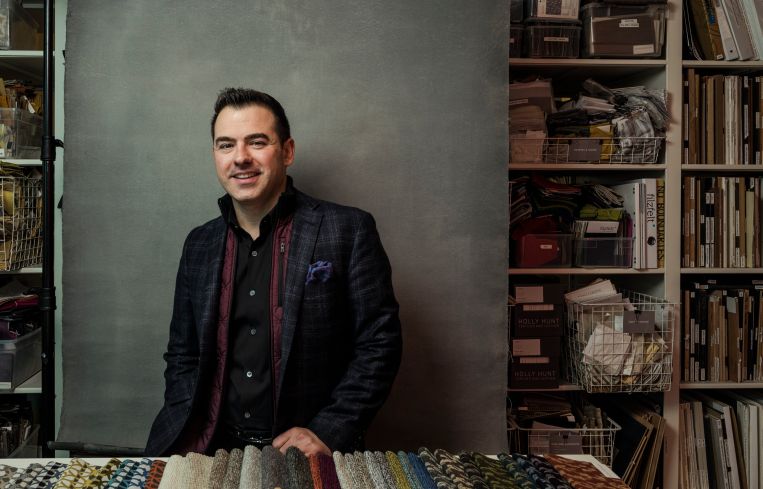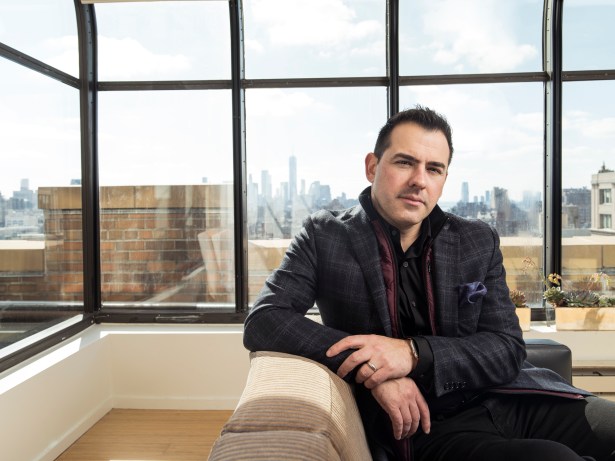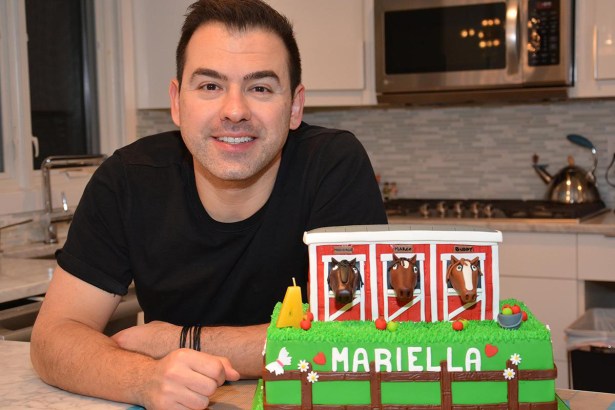Mancini Duffy’s Christian Giordano on Architecture’s Tech Revolution
By Rey Mashayekhi February 14, 2018 9:30 am
reprints
Five years ago, Christian Giordano was a young architect who had worked his way up to the role of director of architectural design at HLW International when a friend and former colleague rang him up about a career opportunity.
“He called me and said, ‘Hey, I have a good friend, he’s looking for a young guy to come and kind of revitalize his firm—could you come and meet him?’ ” Giordano recalled. “I asked who, and he said, ‘I’m not going to tell you; we want to keep this kind of quiet. Why don’t we just meet for breakfast?’ So I went and I met Ralph Mancini.”
Giordano and the Mancini Duffy founder, who passed away in 2015, “hit it off” at that breakfast, their conversations leading to Giordano’s joining the architecture and interior design firm as a principal and director of architecture in 2013. A year later, he was elevated to the role of president and is now Mancini Duffy’s majority owner—the person most responsible for guiding the 80-person firm into the future.
And that’s exactly what Giordano has set about doing. Taking a cue from the young, innovative tech- and creative-class companies that form a good chunk of Mancini Duffy’s client roster, Giordano has gone about recalibrating the firm’s approach—emphasizing technology’s potential to transform the way architects and designers work and setting ambitious long-term goals.
Mancini Duffy recently launched its Design Lab, a self-described “in-house incubator” dedicated to researching technologies like 3-D printing; among the firm’s loftier goals is developing the technology enabling the 3-D printing of houses “on a mass production scale” within 30 years, Giordano said. Simultaneously, he is also pushing the traditionally interior design-focused firm to pursue more structural, base building projects, with Mancini Duffy now helming the redevelopment of the historic Palace Theatre, at 1568 Broadway in Times Square, into the TSX Broadway hotel, retail and entertainment complex.
The 44-year-old New Jersey native, who lives in Middletown Township, N.J., with his wife and their two daughters, recently sat down with Commercial Observer at Mancini Duffy’s offices at 275 Seventh Avenue in Chelsea to discuss his career to date, how technology is at the forefront of the firm’s plans for the future and his unique, design-oriented culinary hobby.
Commercial Observer: What drove you to pursue architecture as a career?
Christian Giordano: I credit my mom because she was very into design. She was always renovating our house, constantly. I took a liking to watching the contractors work, and for whatever reason, I’ve wanted to be an architect ever since I was a little kid.
So I applied to the University of Miami—one of my cousins went there, and they had a great architecture school. It was a very traditional program; you did a lot of hand-drawing and hand-drafting. Elizabeth Plater-Zyberk was the dean at the time, and new urbanism was a new concept, so there was a lot of master planning that we did with really large-scale, big-picture thought processes behind it.
The internet was new at the time I went to college. We didn’t have email, and CAD [computer-aided design] was new, and toward the end of that education I was really into the computer and what the computer could do for the world of architecture. And that’s what led me to go to UCLA [for a master’s degree] because they were really at the forefront of computer-aided design. They had a tremendous program where we were even doing early 3-D printing 20 years ago—I still have some of those early prints. It was a departure from the Elizabeth Plater-Zyberk, more-traditional architecture school; Frank Gehry was there, Thom Mayne was there, and I really admired those guys and wanted to work with them.
When I was in Miami, I did an internship for Swanke Hayden Connell Architects, and [Principal] Richard Carlson always said to me, “Hey, if you ever move back to New York, let me know and I can get you a job there.” I don’t know if he was serious or not, but I called him out of the blue, and that’s where I started my career. Within the first six months there, I met my wife. She’s an interior designer by trade but eventually moved over to furniture sales—the design industry was not for her.
I spent probably five years [at Swanke Hayden Connell] and worked on a bunch of projects. And then, the design director went to HLW, and I followed him over there. I worked my way up there, ultimately running a studio; a lot of those studio people at HLW are here [at Mancini Duffy] now. We worked on projects with Google and did a lot of work in China.

After joining Mancini Duffy, you were quickly elevated to the role of president and eventually became majority owner. How did that come about?
It was always the deal that I would be president within a year. Coming from HLW, I thought, “Oh, that’s cool, I’ll be the president.” I had no idea what that really meant, and when I got here, it wasn’t quite what I expected. There were probably about 35 people, and I was under the impression that Mancini was this enormous organization—I had just known the name and the history. And it really was a rebuilding process.
I quickly realized that there weren’t a lot of people at Mancini out there doing business development. So I started getting out there; I used to do it a lot at HLW but not to the level that I do it now. I really thought that being president of the firm was more about mentoring people and doing design critiques and keeping the design direction, and what I realized was that it was really about the responsibility of bringing work in and keeping everybody busy.
It was a little bit of a struggle in the beginning because I’m from a design background—it’s hard to let go when you’re used to being the one who controls every aspect of your design—but the more and more work I started to bring in, the more and more I absolutely loved it. Look, I’m an architect; I don’t pretend that I’m a businessman, whatever that means. And I think that actually is an advantage in the architecture world. A lot of architects like to pretend they know everything, and I fully admit that I don’t.
Tell me about your broader vision for Mancini Duffy—particularly when it comes to the potential that various technologies hold for the future of design.
Mancini’s always been traditionally known for very sophisticated, tried-and-true corporate interiors for financial institutions and law firms. New York has changed a lot, and while clearly much of that still exists, there is a technology boom here. Those are the kinds of clients that I think get a lot of people here jazzed up, especially the younger generation [of designers] that we have here.
With that, the culture of those firms has really permeated here. We’ve been quite inspired by some of the companies we’ve worked with to focus on the technologies that are going to move the architecture world forward and how we can change our business model.
We’re a service provider, and what that means is the more people we have producing and billing hours, the more revenue the firm generates. That’s a terrible business model; you’re selling hours. We want to be able to improve our clients’ experience by getting them better design, more economical design, designing within whatever their constraints are and doing it more efficiently on our side. So we’re trying to use technology to better ourselves in that way—how can technology move us forward and get us away from selling hours? Can the computer actually do some of the design work for us?
We’re really trying to experiment with this idea of generative design: that we can enter parameters of how the client wants certain things designed and let the computer do some of the work or generate some of the ideas—sort of the artificial intelligence of design. There’s always going to be a human input to it because design is emotional and there’s an emotional attachment to it, but how can we push that forward?
So 3-D printing—but not 3-D printing to print cute little models of what we’ve done. We’ve been engaged by Chaminade High School [in Mineola, N.Y.], where we’re actually physically printing a 3-D wall. We’re going to have 12 printers set up in the building as it’s under construction, and for a month straight we’re going to be physically printing a donor wall—all the names of the people who have given money for this new building—that will ultimately be assembled and put up on site.
It’s that kind of, How do we take the technology and actually use it to not only design, not only represent but actually move the profession forward and move the construction process forward? One of our 30-year goals is to actually 3-D print houses on a mass production scale. That’s what we call our B.H.A.G.: our big, hairy, audacious goal.
Of the firm’s current projects, which are you most excited about?
We’re known, obviously, as a corporate interiors firm. I think what’s not as known is that we also do new buildings. 1568 Broadway is our largest project to date; it’s about a 300,000-square-foot building in Times Square with L&L Holding. Awesome project—there are about 15 people here working on it. It’s the old Palace Theatre; the theater is being elevated about 30 feet to create valuable retail space at the bottom. There’s a superstructure being built around it; the old [DoubleTree] hotel is being essentially demolished, but 40 percent of the structure is remaining so that they can keep a certain amount of zoning FAR [floor area ratio] there, and we’re rebuilding that hotel.
We’re the executive architect for the entire thing, and it’s a good example of working little by little with the client and showing them that we actually had the chops to do this. We hired a technical director from Norman Foster’s office who has that kind of experience to lead the team. It’s really going to put us on the map as far as New York City buildings and base building work—we’ve got a Times Square, New York City tower.
We’re also on our third executive airport lounge for American Airlines; we’re starting an airport division here. We’re not going to do airports like an HOK—we’re not going to actually build the terminals or anything like that—but we’re not more aggressively looking to do the interiors of them since we’ve got a few under our belt now.

I hear you have a pretty sophisticated culinary hobby: You design and bake really ornate, decorated cakes. How did you find that as a passion?
Again, I’m from a design background—I’m a design guy. When my first daughter was born, now 10 years ago, those [baking] shows were really popular—Ace of Cakes, Cake Boss. So I was watching them like, “This is just clay architecture model-making; I could totally do this, this is a joke.” My mother-in-law is super into baking, so she would bake, and I’d be like, “This is easy, I’ll make the kid’s first birthday cake.” And it was horrible—way harder than I ever realized.
I watched baking shows a lot. Those two shows were more about the drama, but other competition shows you could actually learn a lot from. So I’d sit at night watching this stuff, determined to get better.
The whole idea was that I’d eventually be able to do it with the kids, and that’s really how it’s turned out. The younger one, she just wants to mess around and loses interest, but the older one actually is now helping, which is pretty cool—we create two simultaneous cakes as we go.
And man, it just took off—all of a sudden I was doing groomsman’s cakes for people in the industry, I was doing kids’ birthday parties. I will not do a wedding cake—that’s way too much pressure. And I’ve probably done, at this point, 50-plus cakes where they’ve just gotten bigger and better. I’ve bought remote control cars and taken them apart so I could get the motors to turn cakes. I’ve had voice recordings in some of them. It’s very time consuming; of course, I have to do it at night. A lot of times I’ll end up having to take a Friday off and focus solely on the cake because the birthday party is on Saturday morning.
So do you expect to continue doing this as just a hobby, or is a side career in baking perhaps in the works?
No, I would never take money for it. People will give me gift cards or something, but it’s just for friends and family. I actually got to meet the Cake Boss, and embarrassingly I told him I could do what he does.



